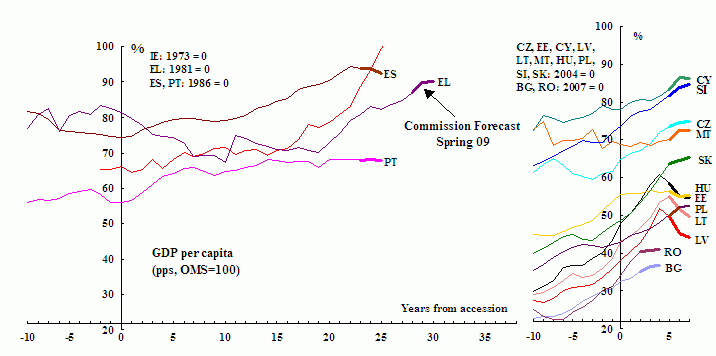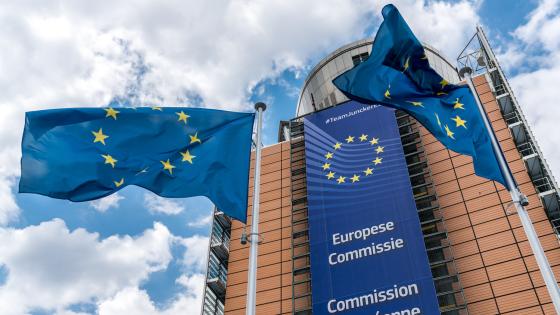The biggest enlargement in the history of the EU took place five years ago. While it may be too soon to draw final conclusions, the findings of a comprehensive report by the European Commission (2009) suggest that the first five years of the enlargement were a major success. The present severe downturn does not put this assessment into doubt, but it certainly highlights many of the future challenges.
New members, old members, and the EU as a whole benefited
In particular, the new member states benefited from faster growth that enabled them to move from GDP per capita that was 40% of the EU-15 average prior to enlargement to 52% in 2008. The EU made a difference. Based on growth regression analysis, it is estimated that each year during the period 2000-2008 accession gave the new member states raised growth by 1.75% on average. This compares favourably with the Commission services' ex ante estimate in 2001 of 1.3% additional growth in a central scenario. Explanatory factors for this growth premium include the productivity improvements due to FDI and the associated transfer of technology. Model simulations suggest that the narrowing of the interest rate spread was also of particular importance. Estimations suggest that the new member states enjoyed a 50-100 basis point advantage relative to other emerging countries with comparable fundamentals starting prior to accession. This contributed 0.3% of additional growth. With the outbreak of the financial crisis in 2007, risk premia have risen, but it seems the new member states continue to benefit in this regard, certainly those under the protective umbrella of the euro.
Old member states gained from enlargement as well. Firstly, they benefited from a larger export market. It is estimated that exports to the new member states in the 5 years after enlargement contributed 1 percentage point on average per year to an overall annual export growth of 6% in the old member states. Partly as a result, most of them realised a comfortable trade surplus with the new member states.
Secondly, the private sector responded to the challenges enlargement brought about by restructuring production networks and locating plants to maximise efficiency. This helped maintain global competitiveness, boost growth all across the EU and ultimately safeguard jobs in the old member states. Sizable short-term adjustment costs arose in some sectors (e.g. food, clothing, publishing, communication equipment, office machinery, motor vehicles) as employment in the old member states was negatively correlated with the rise in employment in the new member states. However, as the report points out, in several sectors (machinery, furniture, medical instruments, chemicals, wood) investment in new member states went hand-in-hand with employment creation in the old members.
Finally, enlargement did not lead to a flood of migrant workers “stealing” jobs in the old member states. Since 2004, about 1.6 million people migrated from new to old member states, bringing the total to 3.6 million. This is less than 1% of the working age population in the old member states, except in Ireland where it reached a much higher level (about 5 %). According to simulations with ECFIN’s QUEST model, this migration adds some 0.4% to GDP in the medium term as bottlenecks in labour markets ease and the skill composition of the migrants is favourable, albeit not optimally used in the short term.
In short, global competitiveness, and thus the growth potential, of the EU economy as a whole strengthened through deepening financial intermediation and integration, accelerated knowledge transfer, and increasing cross-border employment. Increased FDI, cross-border holding of financial assets, and remittances of migrant workers improved allocative efficiency and risk sharing, promoting a higher degree of specialisation and raising productivity all across the enlarged EU.
The EU made a difference, but not every country took full advantage
EU policies and institutions, including the Stability and Growth Pact, the Lisbon agenda, the Single Market rules and the EU transfer system, played an important role, explaining the why benefits of EU enlargement went beyond the classical benefits of economic integration. Structural and cohesion funds provided sizable new resources to lower-income member states, focused efforts on growth-enhancing investments in infrastructure and human capital, and increased the quality of public spending in general. Model-based calculations suggest that the transfers new member states will receive through 2013 from structural and cohesion funds will increase their income level by about 4% permanently.
However, not every country has fully exploited the potential benefits of EU enlargement, and some of the processes involved in economic and financial integration have also created vulnerabilities, mostly because of poor domestic policies. History shows that catching-up cannot be taken for granted, and that it is not a linear process (see Figure 1), pointing at the responsibility of policy makers in this regard. Moreover, the current crisis will no doubt stress test the development model the new members have followed so far. This model was based on easy access to relatively cheap foreign capital (made possible by rapid financial integration) and led to rapid financial deepening in these countries. Thus, these countries could not only exploit investment opportunities in productive sectors but also significantly raise consumption and increase housing investment.
Figure 1. Catching up, then and now
A three-pronged strategy to safeguard achievements
The EU is facing the most severe global economic crisis since its creation. This crisis may have strong longer-term effects on potential growth, as the relative price of risk is likely to have increased significantly and the pace of financial integration and deepening could slow down as a result of the necessary re-regulation of the financial system. As the new member states were particularly affected, real convergence may be hindered in the longer run. To preserve cohesion in the EU, it is essential to ensure that the setback is only temporary.
The new member states are not left on their own. The European Commission is working on a three-pronged strategy to respond to the crisis. First, it is crucial to enhance multilateral surveillance with a view to reducing external vulnerabilities. A significant part of foreign capital has been allocated to non-productive uses and foreign exchange risk has not been allocated optimally in the system, leaving households and firms in the non-tradable sector with too much currency risk. Private markets have also created sizable maturity mismatches, mostly in the financial system and in foreign exchange. Maintaining fiscal sustainability will be critical to keep interest rates low and avoid the crowding out of private business. While the Stability and Growth Pact will most certainly play a central role in this regard, strong national fiscal frameworks are equally important. The Lisbon agenda is more relevant than ever, as the reforms identified in this process are crucial to counterbalance the negative impact of the crisis on potential growth and to increase the resilience of European economies.
Second, more financial resources have been made available based on a case-by-case basis reflecting the fact that new member states differ (as illustrated, for example, by their interest rate differentials). The EU Balance of Payments facility was increased in two steps from €12 to €50 billion. As part of a multilateral rescue effort, also involving the IMF and the World Bank and based on a programme including strong conditionality, three countries (Hungary, Latvia and Romania) have so far tapped this facility for a total amount of €14.6 billion. Other international financial institutions (such as the European Investment Bank and the European Bank for Reconstruction and Development) have also stepped up their lending targets for 2009-10 to provide co-ordinated financial assistance mainly through equity and debt finance for private firms and credit lines for banks. The EU also contributed significantly to the increase of financial resources of the IMF in the form of a €75 billion loan. Finally, through advance payments amounting to €2.3 billion, on top of the €4.7 billion normally envisaged in 2009, EU transfers to the new member states were front-loaded.
Given the importance of strengthening financial markets, the third element of the strategy is to foster co-operation between home and host supervisors and to get parent banks from the old member states on board in the multilateral support programmes. Home supervisors should assume primary responsibility for ensuring proper recapitalisation, guarantees, and external liquidity for the banking groups as a whole, while host supervisors and macroeconomic policy makers need to focus on macroeconomic stability, adequate oversight of portfolio quality and risk management, and preserving appropriate liquidity and capital buffers. The assistance packages should be flanked by a commitment of parent banks to maintain their exposure to the countries concerned and to recapitalise foreign-based subsidiaries if the results of stress-tests indicate the need for such action. Romania and Hungary were the first EU member states where this new approach was applied.1 Enhanced monitoring of parent banks' commitments is undertaken in the context of the reporting requirements under the balance-of-payments assistance. BIS data through the last quarter of 2008 indicate worldwide deleveraging by banks, but this process is least pronounced in the new member states, most likely because of their EU membership.
Summing up, the 2004/07 enlargement made the EU more competitive, and it is therefore better positioned to face the new challenges that the current crisis has created. By eliminating trade barriers, gradually allowing higher cross-border labour mobility, promoting financial integration, strengthening institutions, and significantly reducing political risk in the new member states, enlargement brought about major benefits for both old and new member states. Notwithstanding these achievements, the financial crisis has revealed major vulnerabilities that are not limited to the new member states because of the increased interdependencies within the enlarged EU. These vulnerabilities need to be addressed and adequate measures should be taken to limit the setback to real convergence within the EU.
Note: This column does not necessarily reflect the views of the European Commission. The authors write in their personal capacity.
References
European Commission (2009) Five Years of an Enlarged EU: Economic Achievements and Challenges.
1 See joint EC/IMF press releases of 19 May 2009 on Romania and of 20 May 2009 on Hungary.





